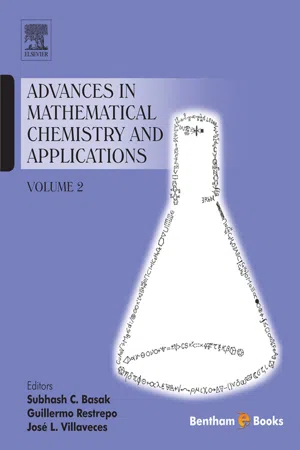
Advances in Mathematical Chemistry and Applications: Volume 2
- 354 pages
- English
- ePUB (mobile friendly)
- Available on iOS & Android
Advances in Mathematical Chemistry and Applications: Volume 2
About This Book
Advances in Mathematical Chemistry and Applications highlights the recent progress in the emerging discipline of discrete mathematical chemistry. Editors Subhash C. Basak, Guillermo Restrepo, and Jose Luis Villaveces have brought together 27 chapters written by 68 internationally renowned experts in these two volumes.
Each volume comprises a wise integration of mathematical and chemical concepts and covers numerous applications in the field of drug discovery, bioinformatics, chemoinformatics, computational biology, mathematical proteomics, and ecotoxicology.
Volume 2 explores deeper the topics introduced in Volume 1, with numerous additional topics such as topological approaches for classifying fullerene isomers; chemical reaction networks; discrimination of small molecules using topological molecular descriptors; GRANCH methods for the mathematical characterization of DNA, RNA and protein sequences; linear regression methods and Bayesian techniques; in silico toxicity prediction methods; drug design; integration of bioinformatics and systems biology, molecular docking, and molecular dynamics; metalloenzyme models; protein folding models; molecular periodicity; generalized topologies and their applications; and many more.
- Brings together both the theoretical and practical aspects of the fundamental concepts of mathematical chemistry
- Covers applications in diverse areas of physics, chemistry, drug discovery, predictive toxicology, systems biology, chemoinformatics, and bioinformatics
- About half of the book focuses primarily on current work, new applications, and emerging approaches for the mathematical characterization of essential aspects of molecular structure, while the other half describes applications of structural approach to new drug discovery, virtual screening, protein folding, predictive toxicology, DNA structure, and systems biology
Frequently asked questions
Information
Topological Efficiency Approach to Fullerene Stability - Case Study with C50
2 Department of Pure Mathematics, Faculty of Mathematical Sciences, University of Kashan, Kashan 87317 – 51167, I. R. Iran
3 Actinium Chemical Research, Via Casilina 1626/A, 00133 Rome, Italy
* Actinium Chemical Research, Via Casilina 1626/A, 00133 Rome, Italy; Tel/Fax: + 39-06-2055084 [email protected]
Abstract:
Keywords
Introduction
Table of contents
- Cover image
- Title page
- Table of Contents
- Copyright
- Cover Art
- Foreword
- Preface
- List of Contributors
- Acknowledgements
- Chapter 1: Topological Efficiency Approach to Fullerene Stability - Case Study with C50
- Chapter 2: Similarity in Chemical Reaction Networks: Categories, Concepts and Closures
- Chapter 3: Discrimination of Small Molecules Using Topological Molecular Descriptors
- Chapter 4: The Periodicity of Molecules
- Chapter 5: The GRANCH Techniques for Analysis of DNA, RNA and Protein Sequences
- Chapter 6: Linear Regression, Model Averaging, and Bayesian Techniques for Predicting Chemical Activities from Structure
- Chapter 7: Marine Algal Toxicity Models with Dunaliella tertiolecta: In Vivo and In Silico
- Chapter 8: Anti-Tubercular Drug Designing Using Structural Descriptors
- Chapter 9: Integrating Bioinformatics and Systems Biology for Exploring Novel Lipid Pathways in Infectious Diseases
- Chapter 10: Applications of Molecular Docking and Molecular Dynamics on the Inhibition of Quorum Sensing Systems
- Chapter 11: Designing Models for Metalloenzymes
- Chapter 12: The Multi-Factor Coupled Protein Folding: Insights from Molecular Dynamics Simulations
- Chapter 13: Generalized Topologies: Hypergraphs, Chemical Reactions, and Biological Evolution
- Subject Index